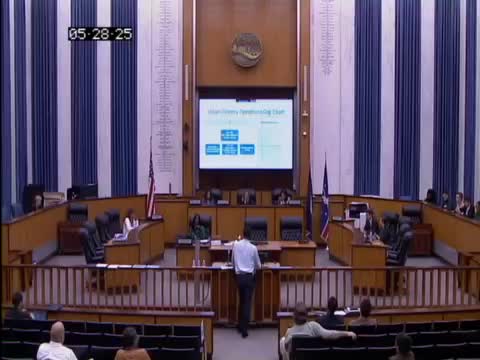Richmond plans Urban Forest Master Plan to enhance tree canopy and community engagement
May 28, 2025 | Richmond City (Independent City), Virginia
This article was created by AI summarizing key points discussed. AI makes mistakes, so for full details and context, please refer to the video of the full meeting. Please report any errors so we can fix them. Report an error »

In a recent meeting of the Richmond City Governmental Operations Standing Committee, city officials discussed the ongoing efforts and challenges faced by the Department of Public Works in managing the urban forestry program. The meeting highlighted the importance of tree maintenance and the city's commitment to enhancing its urban canopy, which is crucial for environmental health and community well-being.
The department currently employs four arborists, with plans to hire a fourth to address the increasing demands for tree inspections and maintenance. Over the past two years, the city has added two new arborists, which has helped manage the city's tree care responsibilities across four designated zones. The arborists respond to maintenance requests primarily through the city's 3-1-1 system, ensuring that safety concerns, particularly those involving street closures, are prioritized.
During the meeting, officials reported conducting approximately 230 tree inspections per month, with a goal of addressing requests within five business days. However, challenges such as inclement weather and the complexity of tree removals—especially those near power lines—can extend wait times significantly. Currently, the average wait for tree removal is around 140 days, raising concerns among council members about the responsiveness of the program to hazardous trees.
The discussion also touched on the city's urban forest master plan, which is set to kick off in the coming months. This four-year initiative aims to assess the current state of Richmond's tree canopy, which was last evaluated in 2010 when it was reported at 42%. The new plan will involve community engagement to gather input on tree planting and maintenance priorities, with a long-term goal of increasing the canopy to 60% as outlined in the Richmond 300 plan.
Additionally, the meeting introduced the concept of a tree canopy bank, a new legislative tool that allows developers to contribute financially if they cannot meet tree planting requirements. This initiative aims to enhance the city's tree cover while providing a funding mechanism for future urban forestry projects.
Council members expressed support for increasing the number of arborists to better meet community needs and improve response times for tree-related issues. The meeting concluded with a commitment to keep the council informed about progress on the urban forestry master plan and other initiatives aimed at enhancing Richmond's green spaces.
Overall, the discussions underscored the city's dedication to improving its urban forestry management while addressing the challenges posed by staffing and resource limitations. As Richmond moves forward, the success of these initiatives will depend on effective planning, community involvement, and adequate funding.
The department currently employs four arborists, with plans to hire a fourth to address the increasing demands for tree inspections and maintenance. Over the past two years, the city has added two new arborists, which has helped manage the city's tree care responsibilities across four designated zones. The arborists respond to maintenance requests primarily through the city's 3-1-1 system, ensuring that safety concerns, particularly those involving street closures, are prioritized.
During the meeting, officials reported conducting approximately 230 tree inspections per month, with a goal of addressing requests within five business days. However, challenges such as inclement weather and the complexity of tree removals—especially those near power lines—can extend wait times significantly. Currently, the average wait for tree removal is around 140 days, raising concerns among council members about the responsiveness of the program to hazardous trees.
The discussion also touched on the city's urban forest master plan, which is set to kick off in the coming months. This four-year initiative aims to assess the current state of Richmond's tree canopy, which was last evaluated in 2010 when it was reported at 42%. The new plan will involve community engagement to gather input on tree planting and maintenance priorities, with a long-term goal of increasing the canopy to 60% as outlined in the Richmond 300 plan.
Additionally, the meeting introduced the concept of a tree canopy bank, a new legislative tool that allows developers to contribute financially if they cannot meet tree planting requirements. This initiative aims to enhance the city's tree cover while providing a funding mechanism for future urban forestry projects.
Council members expressed support for increasing the number of arborists to better meet community needs and improve response times for tree-related issues. The meeting concluded with a commitment to keep the council informed about progress on the urban forestry master plan and other initiatives aimed at enhancing Richmond's green spaces.
Overall, the discussions underscored the city's dedication to improving its urban forestry management while addressing the challenges posed by staffing and resource limitations. As Richmond moves forward, the success of these initiatives will depend on effective planning, community involvement, and adequate funding.
View full meeting
This article is based on a recent meeting—watch the full video and explore the complete transcript for deeper insights into the discussion.
View full meeting
